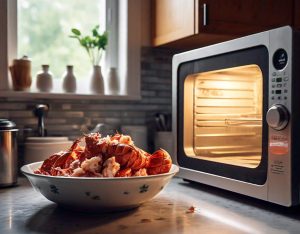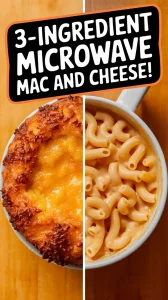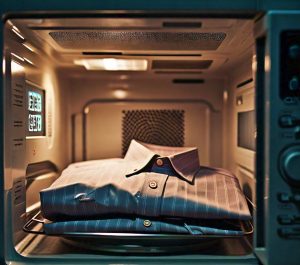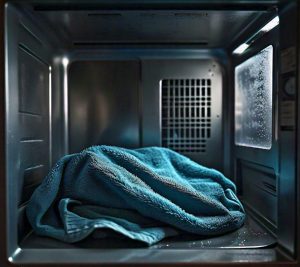Craving seafood pasta but short on time? We’ve got you covered with three delicious recipes you can whip up right in your microwave.
These recipes are surprisingly fast, easy, and require minimal cleanup—perfect for busy weeknights.
Let’s explore how to make shrimp scampi, seafood alfredo, and lobster pasta using just your microwave.
Jump To:
The Lazy Shrimp Scampi Microwave Hack
We discovered this game-changing shrimp scampi method during one of our late-night cooking experiments. What normally takes 20-30 minutes on the stovetop transforms into a 8-minute microwave masterpiece.
The secret lies in using pre-cooked shrimp and angel hair pasta. Angel hair cooks faster than other pasta shapes, making it perfect for microwave preparation. We combine 8 oz of pasta with 2 cups of hot broth, 3 tablespoons of butter, and minced garlic in a microwave-safe dish.
From our experience, the key is covering the dish tightly with microwave-safe plastic wrap and cooking on high for 4-5 minutes. Let it rest for 2 minutes, then stir in the pre-cooked shrimp, lemon juice, and red pepper flakes.
One mistake we made early on was adding the shrimp too soon. The shrimp becomes rubbery when overcooked in the microwave. Always add shrimp during the last minute of cooking time to maintain that perfect tender texture.
One-pot Seafood Alfredo Microwave Simmer Method
Our microwave alfredo technique revolutionizes this creamy classic. We use a combination of heavy cream, butter, and freshly grated Parmesan cheese to create that rich, velvety sauce without constant stirring.
Start with 12 oz of fettuccine in a large microwave-safe bowl. Add 3 cups of hot chicken or seafood stock, ensuring the pasta is completely submerged. Microwave uncovered for 6 minutes at 80% power, then stir and continue for another 4-6 minutes.
What we found works best is creating the alfredo sauce separately. Combine 1 cup heavy cream, 4 tablespoons butter, and 1 cup grated Parmesan in a microwave-safe measuring cup. Heat in 30-second intervals, whisking between each interval.
For the seafood component, we prefer using a mixed seafood medley – scallops, shrimp, and crab meat work beautifully. Add the seafood during the last 2 minutes of pasta cooking time. The residual heat cooks delicate seafood perfectly without making it tough.
Reheating and Enhancing Lobster Pasta in the Microwave
Leftover lobster pasta presents unique challenges, but we’ve mastered the art of microwave reheating without sacrificing texture. The key is adding moisture and controlling the heat distribution.
We recommend adding 2-3 tablespoons of heavy cream or white wine to the pasta before reheating. This prevents the sauce from separating and keeps the lobster meat tender. Cover the dish with a damp paper towel to create steam and ensure even heating.
From our testing, 50% power for 2-3 minutes works best for single servings. Stir halfway through and check the internal temperature. The pasta should reach 165°F for food safety, but avoid overheating as lobster meat becomes chewy quickly.
To enhance reheated lobster pasta, we often add fresh herbs like basil or parsley, a squeeze of lemon juice, and sometimes a sprinkle of red pepper flakes. These additions breathe new life into day-old pasta and brighten the overall flavor profile.
Also See: Quick & Easy Microwave Mango Coconut Mug Cake Recipe
Essential Tips for Perfect Microwave Seafood Pasta
We’ve learned through countless microwave pasta experiments that timing and power control make all the difference. Getting perfect seafood pasta in the microwave isn’t just about throwing ingredients together—it requires specific techniques.
From our experience, the biggest mistake home cooks make is using full power throughout the entire cooking process. We recommend starting at 80% power for the pasta and dropping to 50% when adding delicate seafood. This prevents overcooking and maintains tender textures.
One technique we swear by is the “rest and stir” method. After each cooking interval, let the dish rest for 30-60 seconds before stirring. This allows heat to distribute evenly and prevents hot spots that can make seafood rubbery.
Water temperature matters more than most people realize. We always use hot or boiling water when starting pasta in the microwave. Cold water extends cooking time by 3-4 minutes and can result in uneven cooking.
For seafood specifically, we’ve found that pre-cooked frozen seafood works better than raw in microwave recipes. Raw seafood can release excess moisture that dilutes sauces and creates soggy pasta. If you must use raw seafood, add it during the final 1-2 minutes only.
One trick we discovered is adding a tablespoon of olive oil to the cooking liquid. This prevents pasta from sticking together and adds richness to the final dish. Never skip the salt in your cooking liquid—this is your only chance to season the pasta itself.
Choosing the Right Pasta for Microwave Cooking
Not all pasta shapes are created equal when it comes to microwave cooking. We’ve tested dozens of varieties, and some consistently outperform others in terms of texture and cooking time.
Angel hair and thin spaghetti are our top choices for microwave seafood pasta. These shapes cook quickly and evenly, typically requiring only 4-6 minutes in the microwave. Their delicate texture pairs beautifully with seafood without overwhelming the dish.
Penne and rigatone work well too, but require longer cooking times—usually 8-10 minutes. The tubular shapes hold sauce nicely, making them perfect for creamy alfredo-style seafood pasta. We recommend breaking long pasta shapes in half to ensure they fit properly in microwave-safe dishes.
From our testing, we’ve found that whole wheat pasta takes 2-3 minutes longer than regular pasta in the microwave. The extra fiber content requires more moisture and heat to soften properly. If you prefer whole wheat, add an extra 1/4 cup of liquid to prevent drying out.
One mistake we made early on was using lasagna sheets or large shells. These thick pasta shapes don’t cook evenly in the microwave and often end up with tough spots. Stick to thinner, more delicate shapes for best results.
Fresh pasta is another story entirely. We’ve found it cooks too quickly in the microwave—often becoming mushy within 2-3 minutes. Reserve fresh pasta for stovetop cooking and stick with dried pasta for microwave recipes.
The pasta-to-liquid ratio is crucial for microwave cooking. We use a 1:2.5 ratio—for every cup of pasta, we add 2.5 cups of liquid. This ensures complete absorption without leaving excess water that can make the dish soggy.
Ready to Dive Into Your Microwave Seafood Adventure?
We’ve shared our three go-to microwave seafood pasta recipes that’ll transform your quick meal game forever. From the buttery garlic notes of shrimp scampi to the creamy richness of seafood alfredo, these dishes prove that microwave cooking doesn’t mean sacrificing flavor. The lobster pasta reheating method alone will save you from countless disappointing leftover experiences.
Grab your favorite microwave-safe bowl and give these recipes a shot tonight. Start with whichever seafood calls to you most – whether it’s succulent shrimp, tender scallops, or luxurious lobster. Your taste buds will thank you, and your schedule will love the convenience. Trust us, once you master these microwave techniques, you’ll wonder why you ever stressed over stovetop seafood pasta again.






